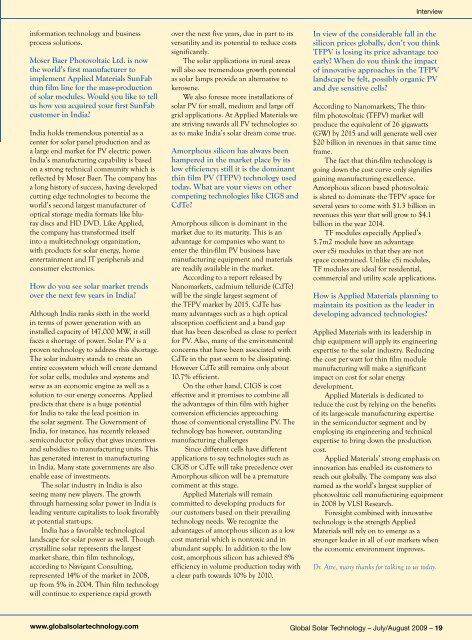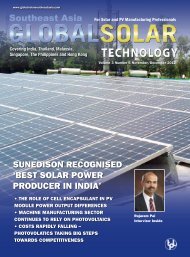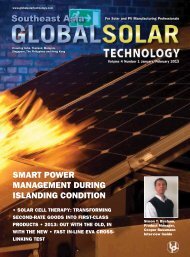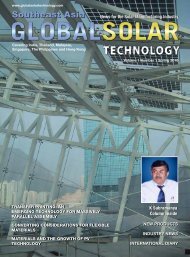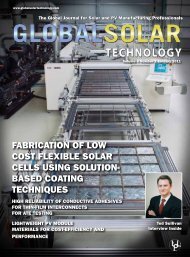download the PDF - Global Solar Technology
download the PDF - Global Solar Technology
download the PDF - Global Solar Technology
You also want an ePaper? Increase the reach of your titles
YUMPU automatically turns print PDFs into web optimized ePapers that Google loves.
Interview<br />
information technology and business<br />
process solutions.<br />
Moser Baer Photovoltaic Ltd. is now<br />
<strong>the</strong> world’s first manufacturer to<br />
implement Applied Materials SunFab<br />
thin film line for <strong>the</strong> mass-production<br />
of solar modules. Would you like to tell<br />
us how you acquired your first SunFab<br />
customer in India?<br />
India holds tremendous potential as a<br />
center for solar panel production and as<br />
a large end market for PV electric power.<br />
India’s manufacturing capability is based<br />
on a strong technical community which is<br />
reflected by Moser Baer. The company has<br />
a long history of success, having developed<br />
cutting edge technologies to become <strong>the</strong><br />
world’s second largest manufacturer of<br />
optical storage media formats like bluray<br />
discs and HD DVD. Like Applied,<br />
<strong>the</strong> company has transformed itself<br />
into a multi-technology organization,<br />
with products for solar energy, home<br />
entertainment and IT peripherals and<br />
consumer electronics.<br />
How do you see solar market trends<br />
over <strong>the</strong> next few years in India?<br />
Although India ranks sixth in <strong>the</strong> world<br />
in terms of power generation with an<br />
installed capacity of 147,000 MW, it still<br />
faces a shortage of power. <strong>Solar</strong> PV is a<br />
proven technology to address this shortage.<br />
The solar industry stands to create an<br />
entire ecosystem which will create demand<br />
for solar cells, modules and systems and<br />
serve as an economic engine as well as a<br />
solution to our energy concerns. Applied<br />
predicts that <strong>the</strong>re is a huge potential<br />
for India to take <strong>the</strong> lead position in<br />
<strong>the</strong> solar segment. The Government of<br />
India, for instance, has recently released<br />
semiconductor policy that gives incentives<br />
and subsidies to manufacturing units. This<br />
has generated interest in manufacturing<br />
in India. Many state governments are also<br />
enable ease of investments.<br />
The solar industry in India is also<br />
seeing many new players. The growth<br />
through harnessing solar power in India is<br />
leading venture capitalists to look favorably<br />
at potential start-ups.<br />
India has a favorable technological<br />
landscape for solar power as well. Though<br />
crystalline solar represents <strong>the</strong> largest<br />
market share, thin film technology,<br />
according to Navigant Consulting,<br />
represented 14% of <strong>the</strong> market in 2008,<br />
up from 5% in 2004. Thin film technology<br />
will continue to experience rapid growth<br />
over <strong>the</strong> next five years, due in part to its<br />
versatility and its potential to reduce costs<br />
significantly.<br />
The solar applications in rural areas<br />
will also see tremendous growth potential<br />
as solar lamps provide an alternative to<br />
kerosene.<br />
We also foresee more installations of<br />
solar PV for small, medium and large off<br />
grid applications. At Applied Materials we<br />
are striving towards all PV technologies so<br />
as to make India’s solar dream come true.<br />
Amorphous silicon has always been<br />
hampered in <strong>the</strong> market place by its<br />
low efficiency; still it is <strong>the</strong> dominant<br />
thin film PV (TFPV) technology used<br />
today. What are your views on o<strong>the</strong>r<br />
competing technologies like CIGS and<br />
CdTe?<br />
Amorphous silicon is dominant in <strong>the</strong><br />
market due to its maturity. This is an<br />
advantage for companies who want to<br />
enter <strong>the</strong> thin-film PV business have<br />
manufacturing equipment and materials<br />
are readily available in <strong>the</strong> market.<br />
According to a report released by<br />
Nanomarkets, cadmium telluride (CdTe)<br />
will be <strong>the</strong> single largest segment of<br />
<strong>the</strong> TFPV market by 2015. CdTe has<br />
many advantages such as a high optical<br />
absorption coefficient and a band gap<br />
that has been described as close to perfect<br />
for PV. Also, many of <strong>the</strong> environmental<br />
concerns that have been associated with<br />
CdTe in <strong>the</strong> past seem to be dissipating.<br />
However CdTe still remains only about<br />
10.7% efficient.<br />
On <strong>the</strong> o<strong>the</strong>r hand, CIGS is cost<br />
effective and it promises to combine all<br />
<strong>the</strong> advantages of thin film with higher<br />
conversion efficiencies approaching<br />
those of conventional crystalline PV. The<br />
technology has however, outstanding<br />
manufacturing challenges<br />
Since different cells have different<br />
applications to say technologies such as<br />
CIGS or CdTe will take precedence over<br />
Amorphous silicon will be a premature<br />
comment at this stage.<br />
Applied Materials will remain<br />
committed to developing products for<br />
our customers based on <strong>the</strong>ir prevailing<br />
technology needs. We recognize <strong>the</strong><br />
advantages of amorphous silicon as a low<br />
cost material which is nontoxic and in<br />
abundant supply. In addition to <strong>the</strong> low<br />
cost, amorphous silicon has achieved 8%<br />
efficiency in volume production today with<br />
a clear path towards 10% by 2010.<br />
In view of <strong>the</strong> considerable fall in <strong>the</strong><br />
silicon prices globally, don’t you think<br />
TFPV is losing its price advantage too<br />
early? When do you think <strong>the</strong> impact<br />
of innovative approaches in <strong>the</strong> TFPV<br />
landscape be felt, possibly organic PV<br />
and dye sensitive cells?<br />
According to Nanomarkets, The thinfilm<br />
photovoltaic (TFPV) market will<br />
produce <strong>the</strong> equivalent of 26 gigawatts<br />
(GW) by 2015 and will generate well over<br />
$20 billion in revenues in that same time<br />
frame.<br />
The fact that thin-film technology is<br />
going down <strong>the</strong> cost curve only signifies<br />
gaining manufacturing excellence.<br />
Amorphous silicon based photovoltaic<br />
is slated to dominate <strong>the</strong> TFPV space for<br />
several years to come with $1.3 billion in<br />
revenues this year that will grow to $4.1<br />
billion in <strong>the</strong> year 2014.<br />
TF modules especially Applied’s<br />
5.7m2 module have an advantage<br />
over cSi modules in that <strong>the</strong>y are not<br />
space constrained. Unlike cSi modules,<br />
TF modules are ideal for residential,<br />
commercial and utility scale applications.<br />
How is Applied Materials planning to<br />
maintain its position as <strong>the</strong> leader in<br />
developing advanced technologies?<br />
Applied Materials with its leadership in<br />
chip equipment will apply its engineering<br />
expertise to <strong>the</strong> solar industry. Reducing<br />
<strong>the</strong> cost per watt for thin film module<br />
manufacturing will make a significant<br />
impact on cost for solar energy<br />
development.<br />
Applied Materials is dedicated to<br />
reduce <strong>the</strong> cost by relying on <strong>the</strong> benefits<br />
of its large-scale manufacturing expertise<br />
in <strong>the</strong> semiconductor segment and by<br />
employing its engineering and technical<br />
expertise to bring down <strong>the</strong> production<br />
cost.<br />
Applied Materials’ strong emphasis on<br />
innovation has enabled its customers to<br />
reach out globally. The company was also<br />
named as <strong>the</strong> world’s largest supplier of<br />
photovoltaic cell manufacturing equipment<br />
in 2008 by VLSI Research.<br />
Foresight combined with innovative<br />
technology is <strong>the</strong> strength Applied<br />
Materials will rely on to emerge as a<br />
stronger leader in all of our markets when<br />
<strong>the</strong> economic environment improves.<br />
Dr. Atre, many thanks for talking to us today.<br />
www.globalsolartechnology.com <strong>Global</strong> <strong>Solar</strong> <strong>Technology</strong> – July/August 2009 – 19


